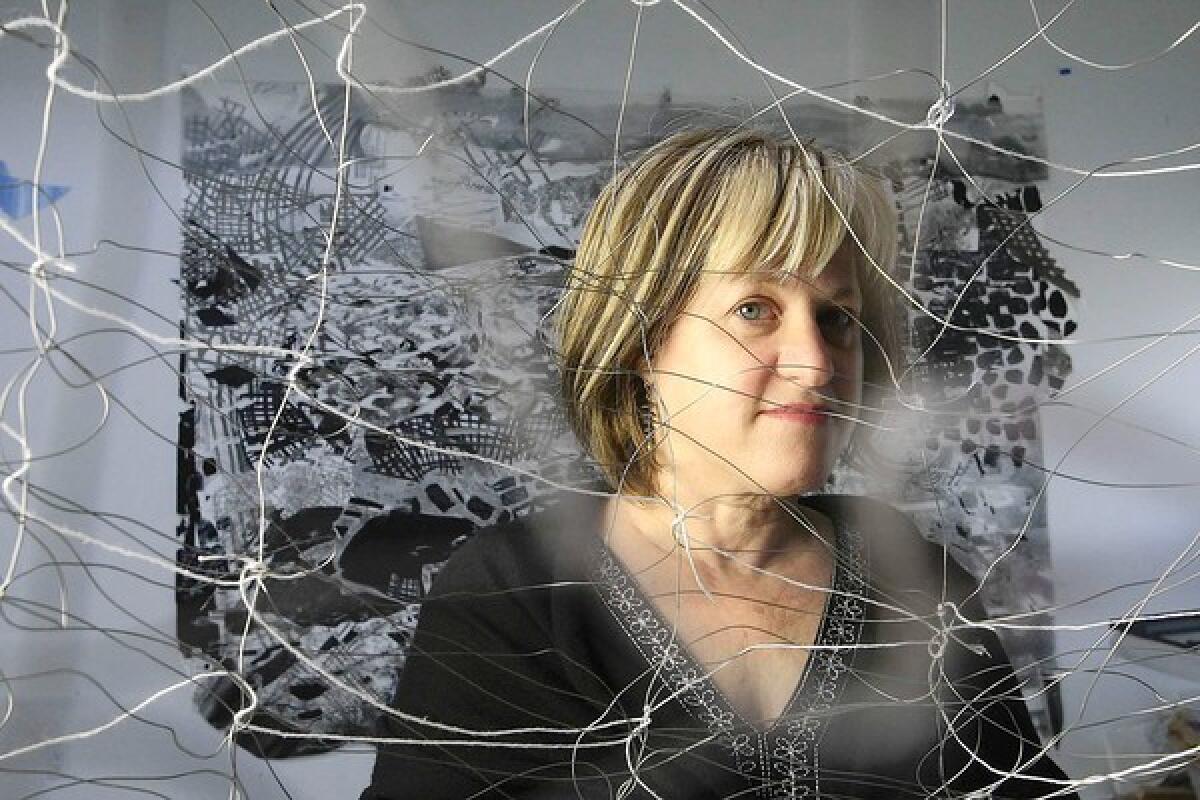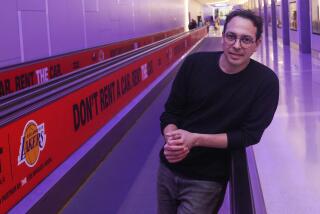In the Studio: Fran Siegel

In the northwest corner of Fran Siegel’s studio, not far from a giant roll of bubble wrap, you’ll find a horizontal band of wire netting suspended between a pair of slender metal armatures, several feet above eye level. But for a few scraps of foil and colored film tied to some of the wires, it isn’t much to look at. Indeed, under most conditions, there is a good chance that you wouldn’t notice it at all. When the sun reaches the right point in the sky, however, angling through a nearby skylight to fall directly across the wires, a twinkling composition of light and shadow springs to life on the wall behind.
Siegel interrupts her discussion of a nearby drawing to point it out before it passes. She describes the work as a visual musical score. “The piece is actually only activated twice a year, in this season,” she says. “I began constructing it last year around this time and then stopped, because in the summer the sun stops here. The studio is on a perfect axis, so about a month ago it projected up there.” She gestures to points on either side of the netting. “Soon this piece won’t exist.”
Spend any time with Siegel or her work and you will find yourself paying closer attention to such conditions: how rooms are shaped, how sunlight moves, the shifting patterns of shadows and the subtle nature of reflected light. She is captivated by questions of spatial and atmospheric perception. Her works — sculptural installations and drawings, primarily — are poetic investigations conducted with the observational rigor of a scientist.
In conversation, Siegel is avid and engaging. Her studio, a comfortably cluttered white box of a space in a San Pedro storefront, is a hub of activity unfolding in multiple directions — her husband, artist Danial Nord, has a studio in the next room, and they live in a renovated space behind. It is filled with static, fragmentary objects, waiting, like the musical score, to be brought to life: swooping nets of string, monofilament, wire and paper; orbs made from plastic sheeting and tape; frail chandeliers resembling the frames of hoop skirts, planted with light bulbs of varying sizes.
“I’m interested in the idea of something that’s not physically solid or substantial having a larger life,” she says. “The opposite of that — what I’m historically reacting against — is the idea of a painting projecting itself into the world the same way each time, such that you could identify it, say, as the red painting or the blue painting. I want for the work to not have that kind of identity. To be more complicated, more reactive to what’s around it, in a constant state of fluctuation.”
Even her drawings, which are basically two-dimensional and static, have a feeling of oscillation and instability. Pieced together from countless fragments of paper, Dura-Lar and cyanotype photographs and large in scale — up to 12 or 13 feet across — they are landscapes of a sort, charting not the appearance so much as the experience of a place. In a series called “Overland,” the most recent incarnation of which will be included in a works on paper show at ACME in July, she creates sprawling, disjointed and disorienting compositions based on aerial photographs taken while flying in and out of Southern California airports.
“Navigation 1,” a large, recently finished piece, documents her exploration of Genoa, Italy, where she spent several months on a residency last fall. Combining elements of landscape imagery, topographical information, patterns based on antique maps, impressions gathered while moving through the city — the spatial organization of stairs she was constantly moving up and down, the sight of nets engulfing olive trees — and allusions to Christopher Columbus (a ship hovers near the bottom of the drawing, a rare figurative element), it is a dizzyingly multidimensional portrait of a port town very different from her own.
Siegel, 51, grew up on Long Island, earned her MFA at Yale in the late 1980s and lived in Manhattan for 15 years before moving to San Pedro in 2002 to take a teaching job at Cal State Long Beach. (She is still represented primarily by a New York gallery, Margaret Thatcher Projects.) It was a pivotal shift, not only for her lifestyle — she praises the availability of reasonable real estate — but for the content of her work.
“When I was in New York, I saw the light as a kind of ricocheting thing, always reflecting from one building onto the façade of another,” she says. “The nuance of that was really interesting to me, but I wasn’t interested in the grid at all. It wasn’t complex enough.” The interaction in Los Angeles of warm, diffuse, atmospheric light and an unruly, decentralized, grid-less shape, came as a revelation.
“Complex” is a word Siegel uses often. Though her installations can be subtle or spare — a cascade of wires flecked with Mylar and small fragments of white porcelain, for instance, between a skylight and a window in LA Louver’s 2009 Rogue Wave show — she is no minimalist. “I like the idea of lots of intersecting things,” she says. Even her hanging chandelier contraptions, slight in themselves, with a precarious sense of handmade delicacy, take over a room when properly illuminated, projecting panoramic tableaux of dancing light and shadow. She refers to these pieces as “drawings in space.”
It is essential to Siegel, however, that this complexity be fluid and responsive to its surroundings. She named the LA Louver piece “Fugitive” because it was designed “to take on the space of whatever it’s given, to transform itself depending on the environment it’s occupying, like a fugitive would.” It is a distinction she draws between her work and the site-specific installation work of earlier eras, namely the historically male-dominated legacy of minimalism.
“I’m interested in disintegration and lightness,” she says. “The idea of negotiating with the space, negotiating with light, not wanting to have a thing be 100% present all the time. These are not male attributes. Trying to make something that disappears have a voice is actually what women go through as people all the time.”
As with the “musical score” in the corner of her studio — a piece whose existence depends on a negotiation with the elusive sunlight — it is a delicate but often dazzling operation.
More to Read
The biggest entertainment stories
Get our big stories about Hollywood, film, television, music, arts, culture and more right in your inbox as soon as they publish.
You may occasionally receive promotional content from the Los Angeles Times.






